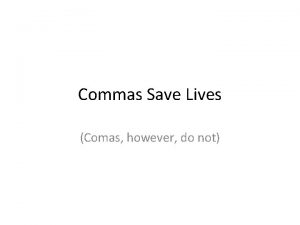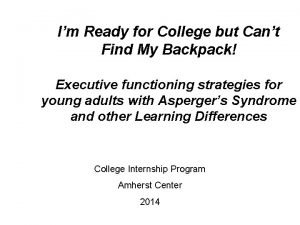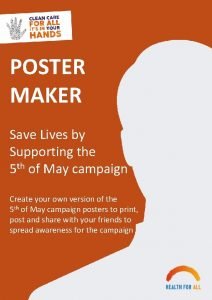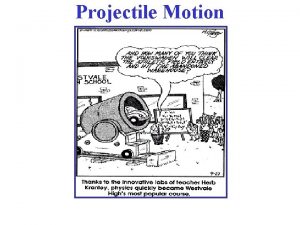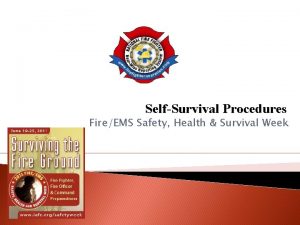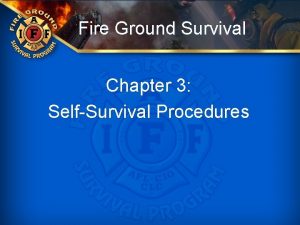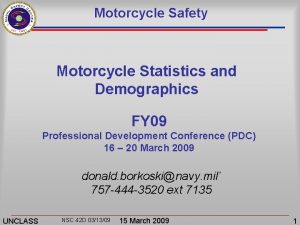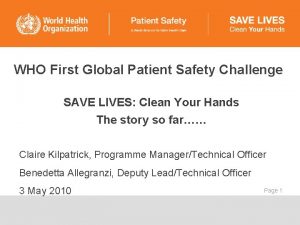MOTORCYCLE SAFETY HOW TO SAVE LIVES AND SAVE










































![A RECENT FOXNEWS. COM ARTICLE STATED THE FOLLOWING: "[A] study from the Centers for A RECENT FOXNEWS. COM ARTICLE STATED THE FOLLOWING: "[A] study from the Centers for](https://slidetodoc.com/presentation_image/e7e57ef8e16b9f00175cbb4b005f826a/image-43.jpg)

![LET’S USE THE STATEMENT MADE BY FOXNEWS. COM "[A] study from the Centers for LET’S USE THE STATEMENT MADE BY FOXNEWS. COM "[A] study from the Centers for](https://slidetodoc.com/presentation_image/e7e57ef8e16b9f00175cbb4b005f826a/image-45.jpg)


















- Slides: 63

MOTORCYCLE SAFETY HOW TO SAVE LIVES AND SAVE MONEY (June 2012) DISSECTING THIS LATEST STUDY BY THE NATIONAL CENTER FOR

OR

PAY NO ATTENTION TO THE MAN BEHIND THE CURTAIN (THE WIZARD OF OZ -1939)

OR

DON’T PISS DOWN MY BACK AND TELL ME IT’S RAINING (OUTLAW JOSEY WALES – 1976)

• In June of 2012 the Centers for Disease Control released a study using 2008 data. • Their conclusion was, predictably, that universal helmet laws save lives and money, and that allowing adults to make their own choices on the subject causes death and a rise in public cost.

“Our role is to identify ways to prevent injury and death and rigorously check what works and what does not work. For motorcycle safety, the research shows that universal helmet laws are the most effective way to reduce the number of deaths and traumatic brain injuries that result from crashes. ” Dr. Thomas Frieden, CDC Director (Page 3 of CDC Study)

Let’s compare this to the June 25, 2012 email from the CDC responding to a request from ABATE of Virginia for information on motorcycle fatalities broken down by the body part injured

Hi Mr. Peterson, Thanks for your inquiry. We do not have Motorcyclist injury deaths tabulated by body region/part. With deaths, there are usually multiple injuries and the primary body part affected is often difficult to determine. You might search the literature to see if anything is published by body region for motorcyclist deaths. I did a search using http: //www. safetylit. org/ but did not see any articles surface on motorcyclist deaths by body part affected. Sorry that I couldn't be of more help. J. Lee Annest, Ph. D. , M. S. Director, Office of Statistics and Programming National Center for Injury Prevention and Control, CDC 4770 Buford Hwy NE, MS - F 64 Atlanta, GA 30341

THE PROBLEM WITH THE CDC STUDY IS THAT IT IS A COLLECTION OF CONCLUSIONS. I. Many of these conclusions do not make sense when we look at the facts. II. Other conclusions do not stand up to close scrutiny. III. Finally, others rest upon logic which, if applied to other activities, would justify government regulation that few American citizens would accept if it were aimed at something they enjoyed.

THE PREMISE OF THE STUDY IS TWOFOLD: • That states which do not have universal helmet laws have much higher fatality rates. • That these states are burdened by higher costs due to un-helmeted motorcyclists being involved in motor vehicle accidents.

FATALITIES “Helmets are the only safety measure proven to save lives. ” (Page 5 CDC study emphasis added)

ACCORDING TO THAT STATEMENT IT MUST BE THE POSITION OF THE CDC THAT: I. Rider education is not a safety measure proven to save lives. II. If given the choice between learning how to control your motorcycle and operate it defensively and responsibly or wearing a helmet – wear a helmet because learning how to control your motorcycle and operate it defensively and responsibly is of no proven safety value.

THE VIRGINIA EXPERIMENT • Virginia took five years’ worth of crash data and with the help of the DMV broke the crashes down between graduates of the Virginia Rider Training Program and non-graduates of that course. • Graduates of the course were extremely underrepresented in the total population of crash victims. • In two out of the five years, out of all of the motorcycle fatalities in the state, NONE were graduates of the rider training course.


FATALITIES NATIONALY ACCORDING TO THE CDC REPORT: 1) Motorcycle-related deaths have increased by 55% since 2000 2) Motorcycle Crashes Killed 4, 502 People in 2010

THOSE NUMBERS COMPARED TO REGISTRATIONS Year Fatalities Registered Motorcycles 2, 862 4, 903, 000 4, 502 8, 368, 000 2010 (National Highway Transportation & Safety Administration) In 2000 - 0. 058% of registered motorcycles were involved in a fatal accident. In 2010 - 0. 053% of registered motorcycles were involved in a fatal accident.

HALF THE NUMBERS PAINT HALF A PICTURE

ALL THE NUMBERS PAINT A WHOLE PICTURE

THE CDC LOVES TO USE FLORIDA AS AN EXAMPLE OF RISING MOTORCYCLE FATLAITIES AFTER REPEAL OF MANDATORY HELMET LAWS HOWEVER According to Florida’s Department of Highway Safety & Motor Vehicles’ report Traffic Safety Facts, October 2010: Motorcycle I. Between 2000 and 2009 motorcycle fatalities increased by 63. 4%. II. Between 2000 and 2009 motorcycle registrations increased by 102. 4%.

CDC STUDY PAGE 6 “People who do not wear helmets are more likely to be killed in a crash. Forty-one percent of motorcycle operators and 51% of motorcycle passengers who died in 2008 were not wearing a helmet. ”

CDC STUDY PAGE 6 (RESTATED) “People who wear helmets are more likely to be killed in a crash. 59% percent of motorcycle operators and 49% of motorcycle passengers who died in 2008 were wearing a helmet. ”

THE FATALITY STATISTICS USED BY THE CDC ARE MEANINGLESS I. For the non-helmeted fatalities that died of trauma to internal organs, the fact that they were not wearing a helmet is irrelevant. II. There is no way to tell whether a non-helmeted rider who died of a head injury would have survived had they worn a helmet. III. It never analyzes cause of death IV. We know that the CDC has admitted that with deaths “there are usually multiple injuries and the primary body part affected is often difficult to determine. ” V. The study fails to compare these statistics to actual motorcycle registrations.

THE PUBLIC COST ARGUMENT The second argument of the CDC study is that forcing all motorcyclists to wear a helmet would save money. On page 21 under “Quick Facts” the CDC study makes two assertions without giving us any analysis as to how they came to these conclusions. I. The United States saved $3 billion due to helmet use in 2010. II. The United States could have saved an additional $1. 4 billion in 2010 if all motorcyclists had worn helmets.

LET’S SEE WHAT HAPPENS WHEN WE LOOK AT THIS CRITICALLY If states that allow adults to make their own choice have higher costs we would expect to see that reflected in motor vehicle insurance rates since we know that the costs borne by the insurance industry are passed on to the consumer by way of insurance rates.

THE TOP 5 MOST EXPENSIVE STATES FOR MOTORVEHICLE INSURANCE • Louisiana (Universal Helmet Law) • Oklahoma (Choice) • Michigan (Universal Helmet Law at Time of Study) • West Virginia (Universal Helmet Law) • Washington DC (Universal Helmet Law) (Insure. com)

THE TOP 5 LEAST EXPENSIVE STATES FOR MOTOR VEHICLE INSURANCE • Maine (Choice) • Iowa (Choice) • Wisconsin (Choice) • Idaho (Choice) • North Carolina (Universal Helmet law)

THE 10 LEAST EXPENSIVE STATES FOR MOTOR VEHICLE INSURANCE • Maine (Choice) Helmet Law) • Iowa (Choice) • Ohio (Choice) • Wisconsin (Choice) • South Carolina (Choice) • Idaho (Choice) • North Carolina (Universal Helmet law) • Vermont (Universal • New Hampshire (Choice) • Arizona (Choice)

HEALTH CARE COSTS I. In 2010, the Kaiser Family Foundation conducted a study of daily inpatient hospital expenses by state. II. Of the states that fell into the group that spent the most on patients, the majority had universal helmet laws. III. Of the states that fell into the group that spent the least on patients, the majority allowed adults to make their own choice with regard to motorcycle helmet use.

12 MOST EXPENSIVE STATES SEVEN MANDATORY STATES FIVE CHOICE STATES • Arizona (Choice) • New Jersey (Universal Helmet Law) • California (Universal Helmet • Oregon (Universal Helmet Law) • Colorado (Choice) • Rhode Island (Choice) • DC (Universal Helmet Law) • Utah (Choice) • Delaware (Choice) • Washington (Universal Helmet • Maryland (Universal Helmet Law) • Massachusetts (Universal Helmet Law)

12 LEAST EXPENSIVE STATES FOUR MANDATORY STATES EIGHT CHOICE STATES • Alabama (Universal Helmet law) • Montana (Choice) • Arkansas (Choice) • Oklahoma (Choice) • Georgia (Universal Helmet law) • Iowa (Choice) • Kansas (Choice) • Mississippi (Universal Helmet law) • North Dakota (Choice) • South Dakota (Choice) • West Virginia (Universal Helmet law) • Wyoming (Choice)

HELMET LAWS HAVE NO DISCERNIBLE IMPACT ON INSURANCE RATES OR HEALTH CARE COSTS According to the US Census Bureau, in 2009, only 4. 7% of the motor vehicle crash related deaths and injuries involved motorcycles. Statistically, we are not a large enough segment of the population to significantly contribute to the overall cost of motor vehicle related deaths and injuries.

THOSE WHO USE THE PUBLIC COST ARGUMENT SHOULD BEWARE Such an argument must ultimately lead to the conclusion that it is proper for the government to make choices for us in any area where there is a possible public cost. Let’s take head injuries and think it out to its logical conclusion. We will even use the numbers from those who would deny us choice. According to the CDC the United States would have saved 1. 4 billion in 2008 had all motorcyclists worn a helmet.

PUBLIC COSTS FROM FATALITIES In May of 2011 the CDC issued a study on traumatic brain injury related deaths from 1997 -2007. According to that study, from 1997 to 2007 the fatality rate due to traumatic brain injuries for motorcyclists was 14, 972 per every 100, 000 members of the total population. The number for occupants enclosed in a motor vehicle was 87, 510 per every 100, 000 members of the total population. There were six times more traumatic brain injury deaths related to enclosed motor vehicles than motorcycles.

ACCORDING TO THE CDC’S OWN NUMBERS THE UNITED STATES COULD HAVE SAVED AN ADITIONAL 8. 4 BILLION DOLLARS HAD EVERY ENCLOSED MOTOR VEHICLE OPERATOR AND PASSENGER WORN A HELMET

PUBLIC COSTS FROM TRAUMATIC BRAIN INJURIES The Brain Injury Association of Indiana did a study on the causes of traumatic brain injuries, part of which focused transportation related brain injuries. The study looked at injuries during 1995 -1996 in 14 different states, about half of which allowed freedom of choice at the time of the study 6% of transportation related brain injuries involved motorcyclists. 62% involved standard motor vehicles. There were 10 times more transportation related brain injuries involving standard motor vehicles than there were involving motorcyclists.

ACCORDING TO THE CDC’S OWN NUMBERS THE UNITED STATES COULD HAVE SAVED AN ADDITIONAL 14 BILLION DOLLARS HAD EVERY STANDARD MOTOR VEHICLE OPERATOR AND PASSENGER WORN A HELMET

A FINAL NOTE ON PUBLIC DANGERS Below is an excerpt from a 2004 CDC report on causes of death in The United States in 2000. “The leading causes of death in 2000 were tobacco (435 000 deaths; 18. 1% of total US deaths), poor diet and physical inactivity (400 000 deaths; 16. 6%), and alcohol consumption (85 000 deaths; 3. 5%). Other actual causes of death were microbial agents (75 000), toxic agents (55 000), motor vehicle crashes (43 000), incidents involving firearms (29 000), sexual behaviors (20 000), and illicit use of drugs (17 000). ”

According to NHTSA, in 2000 there were 2, 897 motorcycle fatalities in the United States. We will assume half of those were not wearing helmets even though that according to the CDC numbers the actual number would be less. For the purposes of this argument we will further assume that every one of those fatalities who were not wearing a helmet would have survived had they worn a helmet. That means that if all motorcyclists had been forced to wear a helmet in 2000 we would have saved 1, 449 lives.

ACCORDING TO THE 2004 CDC REPORT: I. We could have saved 435, 000 lives by making tobacco illegal. II. We could have saved 400, 000 lives by removing unhealthy foods from grocery store shelves and restaurants. III. We could have saved 85, 000 lives in 2000 by removing people’s choice as to whether they should consume alcohol. IV. We could have saved 29, 000 lives by making firearms illegal.

By removing people’s choices in those areas the government could save 949, 000 lives a year. Instead they want to take away our right to choose under the mistaken belief that they could save less than 2, 000 lives.

BEWARE OF HOW THIS AND SIMILAR STUDIES ARE USED
![A RECENT FOXNEWS COM ARTICLE STATED THE FOLLOWING A study from the Centers for A RECENT FOXNEWS. COM ARTICLE STATED THE FOLLOWING: "[A] study from the Centers for](https://slidetodoc.com/presentation_image/e7e57ef8e16b9f00175cbb4b005f826a/image-43.jpg)
A RECENT FOXNEWS. COM ARTICLE STATED THE FOLLOWING: "[A] study from the Centers for Disease Control and Prevention found that only 12 percent of fatal motorcycle accidents nationwide happened in the 20 states that required helmets for all riders".

WHEN WE SEE SOMETHING LIKE THAT WE SHOULD DO THREE THINGS: • I. Verify the accuracy of the statement. • II. See if the source material is actually of help. • III. See if we can supplement or improve the source material.
![LETS USE THE STATEMENT MADE BY FOXNEWS COM A study from the Centers for LET’S USE THE STATEMENT MADE BY FOXNEWS. COM "[A] study from the Centers for](https://slidetodoc.com/presentation_image/e7e57ef8e16b9f00175cbb4b005f826a/image-45.jpg)
LET’S USE THE STATEMENT MADE BY FOXNEWS. COM "[A] study from the Centers for Disease Control and Prevention found that only 12 percent of fatal motorcycle accidents nationwide happened in the 20 states that required helmets for all riders".

NOW LET’S COMPARE IT TO THE ACTUAL CDC STUDY. CDC researchers looked at the 14, 283 motorcycle fatalities nationwide from 2008 to 2010. I II. They focused on the 6, 057 fatalities that were not wearing a helmet. III. They found that 12 % of the 6, 057 non- helmeted fatalities took place in the 20 states that had a universal helmet law.

SEE IF THE SOURCE MATERIAL IS ACTUALLY OF HELP I. There were 14, 283 motorcycle fatalities nationwide from 2008 to 2010. II. 6, 057 fatalities that were not wearing a helmet. III. That means that of the 14, 283 motorcycle fatalities between 2008 and 2010, 8, 226, or 57. 6% were wearing helmets when they were killed. IV. That further means that the majority of motorcyclists killed between 2008 and 2010 were wearing helmets.

SEE IF WE CAN SUPPLEMENT OR IMPROVE THE SOURCE MATERIAL. (NUMBERS BELOW FROM NHTSA & U. S. CENSUS BUREAU) I. Between 2008 & 2010 there were 14, 283 motorcycle fatalities. II. 6, 118 (43%) occurred in the 21 jurisdictions that had mandatory helmet laws.

III. Those same 21 jurisdictions accounted for 40% of all motorcycle registrations in the U. S. IV. 8, 165 (57%) of all motorcycle fatalities between 2008 & 2010 occurred in the 30 jurisdictions that allowed choice on the issue of helmets. V. Those same 30 jurisdictions accounted for 60% of all motorcycle registrations in the U. S.

WHAT DOES THAT MEAN? I. 41% of the jurisdictions in the United States account for 40% of motorcycle registrations and 43% of all motorcycle fatalities. II. 59% of the jurisdictions in the United States account for 60% of all motorcycle registrations and 57% of all motorcycle fatalities. III. That is a far cry from 12 percent of fatal motorcycle accidents nationwide happened in the 20 states that required helmets for all riders.

Let’s Look at recent articles on the study done by the Highway Loss Data Institute on the effects of Michigan’s modified motorcycle helmet use law on insurance losses.

The average insurance payment on a motorcycle injury claim rose substantially in Michigan after the state changed its helmet law to exempt most riders last year, a new analysis by the Highway Loss Data Institute (HLDI) finds. The result is consistent with previous studies that show that rescinding helmet requirements results in more fatalities and hospital admissions. (Michigan's weakened helmet use law leads to costlier injury claims, Insurance Institute for Highway Safety, May 30, 2013, Pg. 1).

Let’s Look at the Actual Study

The increase in collision claim frequency merits further discussion. Those who argue against helmet laws often state that requiring helmet use discourages people from riding. It is possible that the increase in collision claim frequency was caused by people traveling more miles on motorcycles. (The effects of Michigan’s weakened motorcycle helmet use law on insurance losses, pg. 15)

Information about the type of injury associated with a medical payment claim is not available in the HLDI database. Helmets are designed to reduce head injuries, and knowing if a head injury occurred could greatly improve the analysis. (The effects of Michigan’s weakened motorcycle helmet use law on insurance losses, pg. 16)

It is also unknown whether a rider was wearing a helmet at the time of the crash. Observational studies indicate about half of motorcyclists wear helmets even when not required. (The effects of Michigan’s weakened motorcycle helmet use law on insurance losses, pg. 16)

Page 8 of the study compares med pay claims in 2011 (before the modification) to those in 2012 (the year after the modification). They break the claims down into seven different sub-groups. 1) $0 -$4, 999, 2) $5, 000 - $9, 999, 3) $10, 000 - $14, 999, 4) $15, 000 - $19, 999, 5) $20, 000 - $24, 999, 6)$25, 000 - $29, 999, and 7) $30, 000 and above.

In analyzing the data, it is important to know how medical payment claims work. If I have $3, 000 of medical payment benefits on my bike policy and I get injured, I can claim up to $3, 000 from my insurance company to reimburse me for my medical bills. If I have $2, 000 worth of bills I can claim $2, 000. If I have $3, 000 worth of bills I can claim $3, 000. If I have $500, 000 worth of bills I can only claim $3, 000. An insured who has a $3, 000 policy would be counted in the $0 - $4, 999 group of this study regardless of the actual amount of medical bills.

It is further important to note that under Michigan’s modified helmet law, riders who chose to ride without a helmet must carry at least $20, 000 in medical payments coverage. Keeping these two things in mind let’s look at the comparison made by the study in each category. Also keep in mind that the study’s comparisons are made on a graph which I could not copy. The graph uses bars on a scale broken up in 10% increments. Therefore, these percentages are my estimate erring on the side of the insurance industry.

$0 - $4, 999 decreased by approximately 5% between 2011 and 2012 $5, 000 - $9, 999 decreased by approximately 7% between 2011 and 2012 $10, 000 - $14, 999 decreased by approximately 4% between 2011 and 2012 $15, 000 - $19, 999 decreased by approximately 1% between 2011 and 2012 $20, 000 - $24, 999 increased by approximately 16% between 2011 and 2012 (they actually gave us this number and it was 15. 6% but as I said I erred on their side) $25, 000 - $29, 999 had no change between 2011 and 2012

The study itself admits that it was done without the critical information necessary to make an accurate assessment of the true effects of Michigan’s modified helmet law on insurance losses – if there any to begin with. The data used to show that medical payment claims have risen do not necessarily show that. One could as easily argue that these numbers represent a shift from lower policy limits to the higher $20, 000 limits required to legally ride without a helmet. The fact that claims above $25, 000 have remained unchanged would seem to back that up given that 1) those policies should have been relatively constant between 2011 and 2012, and, 2) serious head injuries generally carry medical bills in excess of $25, 000.

The nine most terrifying words in the English language are: 'I'm from the government and I'm here to help. ” Ronald Reagan “

MATT@MOTORCYCLELAWGROUP. COM
 Basic rider course michigan
Basic rider course michigan Oregon motorcycle safety course
Oregon motorcycle safety course Bikesafe admin
Bikesafe admin Motorcycle safety course oregon
Motorcycle safety course oregon Commas in a series example
Commas in a series example Dont save lives
Dont save lives Arcutha
Arcutha Live poster maker
Live poster maker Difference between save and save as
Difference between save and save as Si te printojme nje dokument
Si te printojme nje dokument Hakim weatherspoon
Hakim weatherspoon The mouse and the motorcycle comprehension questions
The mouse and the motorcycle comprehension questions Kf case
Kf case World motorcycle test cycle
World motorcycle test cycle Speed, velocity and acceleration quiz
Speed, velocity and acceleration quiz Flip flops on motorcycle
Flip flops on motorcycle Motorcycle riders foundation
Motorcycle riders foundation A 250 kg motorcycle is driven around a 12 meter tall
A 250 kg motorcycle is driven around a 12 meter tall April safety topics
April safety topics Takanobu ito
Takanobu ito Motorcycle roundup in atlanta
Motorcycle roundup in atlanta A motorcycle undergoes acceleration when
A motorcycle undergoes acceleration when A motion map for a motorcycle is shown
A motion map for a motorcycle is shown Automobile car motorcycle venn diagram
Automobile car motorcycle venn diagram Icd luka bakar
Icd luka bakar Giacomo balla speed of a motorcycle
Giacomo balla speed of a motorcycle Datatag motorcycle change of ownership
Datatag motorcycle change of ownership Che guevara quotes motorcycle diaries
Che guevara quotes motorcycle diaries After kato's serious motorcycle accident
After kato's serious motorcycle accident Vertical motion examples
Vertical motion examples Explanation
Explanation Kerfi ab
Kerfi ab Ardie motorcycle
Ardie motorcycle I go to school by motorcycle
I go to school by motorcycle Motorcycle engine sizes cc chart
Motorcycle engine sizes cc chart Motorsport sponsorship proposal
Motorsport sponsorship proposal Little bicycle song
Little bicycle song The motorcycle project
The motorcycle project Iso motorcycle
Iso motorcycle Which display mode is allowed for proper navigation?
Which display mode is allowed for proper navigation? Safety care training
Safety care training Personal safety vs process safety
Personal safety vs process safety Ind safety report
Ind safety report Basic safety orientation
Basic safety orientation Basic safety construction site safety orientation
Basic safety construction site safety orientation Fulfilling lives in islington and camden
Fulfilling lives in islington and camden Everything that lives and moves about will be food for you
Everything that lives and moves about will be food for you Championing better work and working lives
Championing better work and working lives Beowulf discussion questions
Beowulf discussion questions Saikat's family
Saikat's family Sgt john wilson
Sgt john wilson Overarching themes in literature
Overarching themes in literature The teacher who lives next door to rob is mrs. johnson
The teacher who lives next door to rob is mrs. johnson Grab lives mnemonic
Grab lives mnemonic Why does meherjan look more than her age
Why does meherjan look more than her age Fill in the gaps using the right preposition of time
Fill in the gaps using the right preposition of time The mass media play an important
The mass media play an important My friends lives in moscow said alec
My friends lives in moscow said alec Sohan lives in a village
Sohan lives in a village Parasitism
Parasitism Grab lives firefighter acronym
Grab lives firefighter acronym Drawing the power of jesus christ into our lives
Drawing the power of jesus christ into our lives What lives in the abyss
What lives in the abyss 6 word memoirs about sports
6 word memoirs about sports




